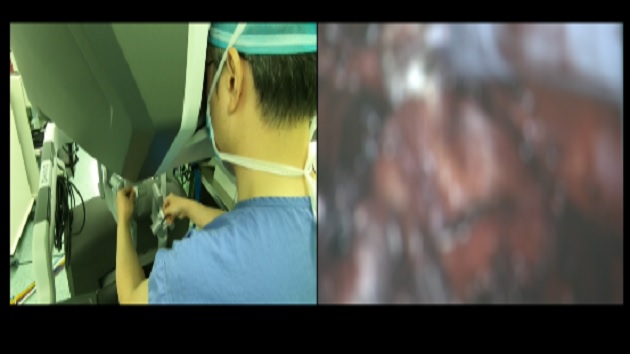
Surgical robots have been introduced to local hospitals.
With the advancement of technology, sophisticated surgery procedures are performed by robots.
Mike Laidman reports.
Tiny robotic hands, having penetrated an equally tiny hole, cut problematic tissue off a patient’s prostate.
The surgeon performs the operation from the same room,
checking their work on a monitor showing a view of the area, magnified ten times.
The robotic hands carefully follow the surgeon’s movements.
This kind of robot-assisted surgery is suitable for operating on small organs like an enlarged prostate gland, uterine myomas, or thyroid nodules.
Jeju has the highest number of prostate cancer cases in all of Korea, meaning that these tiny mechanical hands have an excellent test bed.
Doctors here believe that this new method of surgery is effective in treating prostate cancer.
And these robot hands are still evolving.
The viewing scope has been widened from 60 to 80 degrees, and the width of the robotic hands has been reduced, allowing for more specialised surgeries.
Robot-assisted surgeries can minimize the damage of surrounding tissues as robotic hands don't tremble like human hands inevitably do.
These assisted surgeries also reduce blood loss and the time required for operations, thereby also reducing complications and side effects.
INTERVIEW
Park Kyung-gi / Professor, Jeju National University Hospital
Discomfort and complications after surgery are usually caused by long operations and blood loss. Robotic surgery is precise, minimizes blood loss, and requires less time, reducing many indirect complications.
<인터뷰 : 박경기 / 제주대학교병원 비뇨의학과 교수>
"수술 이후의 합병증은 대부분 긴 수술, 출혈이 만들어내는 경우가 많아요. 근데 이 수술 자체는 굉장히 정밀하고 출혈을 최소화 할 수 있기 때문에 수술 시간이 줄어들고 그걸로 인한 간접적인 합병증들이 줄어들게 됩니다."
This ever-advancing technology means the ability to truly make a difference in a patient’s surgical experience. As such, expect to see more robot-assisted surgeries coming to Jeju.
Mike Laidman, KCTV





